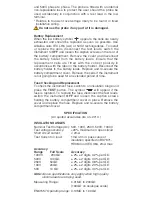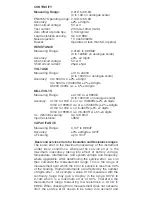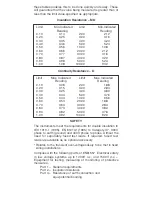
will not be activated when connected to
a diode.
1. Set the selector switch to Ω.
2. Connect the test leads.
3. The test will activate automatically.
4. After the test probes are
disconnected, the
reading will be held for a few
seconds.
Zeroing of Test Lead Resistance
The resistance of the test leads can be
nulled on the continuity range (up to
9,99Ω). The null information is retained in non-volatile memory
and so will be remembered when the instrument is switched off.
1. Select the Continuity range.
2. Short the test leads across a known good conductor using
prods.
3. When the reading has stabilised, press the TEST button.
A short ‘bleep’ will sound and the zero
offset
symbol will appear.
4. To release the zero offset press the test button again.
Possible sources of error
Measurements and results can be effected by the following:
•
The impedance of operating circuits connected in parallel
•
Impedance such as inductors that vary during the
measurement
•
A poor connection to the circuit under test.
Continuity Bleeper
The continuity bleep er sounds continuously when less than
5Ω is detected. Short bleeps will sound for resistances lower
than a few kΩ and above 5Ω.
1. Set the selector switch to
2. Connect the test leads.
Display:
Audible:
<5Ω
continuous bleep
<3kΩ
short bleep
>3kΩ
no bleep
Resistance Tests (kΩ)
This is a low voltage (5V) low current (25µA) test for sensitive
electronic equipment. It operates in the same way as the
continuity ranges.
1. Set the selector switch to kΩ.
2. Connect the test leads.
3. The test will activate automatically.
Voltage Tests (V)
If >1V a.c. or d.c. is present at the terminals the measured voltage
is indicated on the display. The voltage display will function within
FIG.1






























